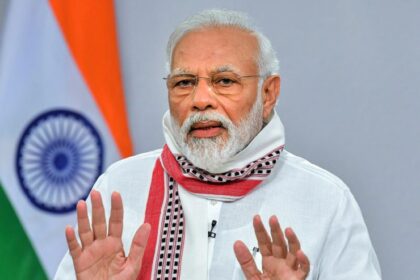Salman Khan’s ₹5.35 Crore Bandra West Apartment Sale Signals Subtle Shift in Celebrity Real Estate Strategy
In the ever-watchful world of celebrity real estate, even the most routine transactions tend to draw public attention, but when one of Bollywood’s biggest stars decides to divest property in Mumbai’s most elite suburb, the ripple effects are more than just tabloid fodder—they reflect subtle shifts in both personal strategy and market confidence. Salman Khan, the iconic actor and one of India’s most bankable cinematic names, has officially sold an apartment in Bandra West for ₹5.35 crore. The sale, while not extravagant by the super-luxury benchmarks of Mumbai’s real estate sector, has set tongues wagging in both entertainment and property circles due to the symbolism embedded in the deal.
The apartment, located in the upscale neighbourhood of Bandra, is part of the elite enclave that has long been synonymous with Bollywood royalty. From Shah Rukh Khan’s Mannat to the residences of Karan Johar, Ranbir Kapoor, and even Salman Khan’s own primary residence at Galaxy Apartments, Bandra West is not merely a postal code—it is a brand in itself. A sale within such a tightly held celebrity cluster is rare and hence, noteworthy.
According to official documents, the transaction was executed earlier this month and recorded with the Mumbai Registrar’s office. The buyer, whose identity remains confidential due to privacy clauses often embedded in such high-value deals, is believed to be a non-celebrity investor. The 1,265-square-foot apartment is located in the elite Carter Road area, one of the most desirable addresses not only in Mumbai but in all of India. Property analysts suggest that the sale price—₹5.35 crore—indicates a per-square-foot value consistent with current market standards for second-tier luxury spaces in the area, as opposed to marquee waterfront listings which command significantly higher premiums.
While the quantum of the deal may not place it in the league of Mumbai’s record-breaking property transactions, it is the person behind the sale that brings layered meaning to this event. Salman Khan has always been a creature of both mystery and visibility. Despite being one of the most publicly followed figures in the country, he has maintained a deliberate distance between his professional aura and private life. His property decisions, therefore, become a rare window into the personal and strategic shifts in his life, career, or business holdings.
Sources close to the matter, though unofficial, indicate that the apartment was not Khan’s primary residence but an investment property that had remained largely unoccupied. With his continued occupancy at Galaxy Apartments just a short distance away, the sale does not suggest a relocation but rather a divestment of idle real estate. This is not uncommon among celebrities with large property portfolios. Maintenance, taxation, and market stagnation in the upper mid-tier segment often prompt such decisions, particularly when the asset does not provide recurring income or fit into a larger redevelopment strategy.
However, industry observers are interpreting this sale as part of a broader recalibration in Salman Khan’s real estate strategy. Over the years, Khan has expanded his investments into multiple domains, including production (via Salman Khan Films), fitness chains, television ventures, and philanthropic initiatives through the Being Human Foundation. Real estate, though a safe haven for wealth, no longer seems to be his dominant focus.
This is not the first time a major Bollywood name has sold or restructured assets in Bandra. Aamir Khan too had divested property in recent years, and similar patterns have emerged with producers and executives within the entertainment ecosystem. One reason, experts say, is the shifting center of gravity within Mumbai itself. With the rise of ultra-luxury towers in Lower Parel, Worli, and even North Mumbai (such as Oshiwara and Versova), the aspirational and functional definition of “celebrity location” is changing. Bandra remains elite but is increasingly viewed as heritage luxury rather than frontier investment.
Beyond market dynamics, there is a more personal interpretation as well. Salman Khan, now in his late 50s, is approaching a phase of life where consolidation often overtakes expansion. His decision to offload a non-core asset, therefore, is not just about real estate—it speaks to a maturing philosophy around asset management, mobility, and lifestyle optimization.
For real estate professionals, the transaction has another layer of relevance—it demonstrates continued liquidity and demand in Bandra West despite macroeconomic headwinds. While the upper end of Mumbai’s housing market has seen a dip in transaction volumes over the past two quarters due to rising interest rates and regulatory changes in capital gains taxation, deals involving celebrity owners inject both confidence and glamour into an otherwise cautious environment.
Moreover, deals such as this have a psychological effect on the market. Investors often interpret celebrity actions as leading indicators. If Salman Khan is selling in Bandra, does that mean the micro-market has peaked? Or is it simply a unique personal move without broader implications? The answers are still speculative, but the conversation itself illustrates how deeply interconnected Mumbai’s real estate narrative is with Bollywood’s movements.
As this transaction continues to gain attention, it raises pertinent questions about the evolving relationship between stardom and asset class. Is real estate still a status symbol among Bollywood elites, or is the culture shifting toward liquidity, agility, and tech-driven investments? How do celebrities navigate public perceptions when selling assets—particularly in high-visibility localities like Bandra?
In the forthcoming sections of this comprehensive article, we will examine historical real estate patterns among major Bollywood actors, track how the value of celebrity-led properties appreciates differently, and analyze whether such transactions serve as market benchmarks or remain anecdotal exceptions. The article will also dive into the legal and financial considerations that celebrities face in property transactions—such as brand impact, privacy structuring, tax implications, and asset reallocation strategies
Salman Khan’s recent decision to part ways with a Bandra West apartment is not an isolated occurrence—it belongs to a wider tapestry of real estate decisions taken by some of India’s most recognisable figures in entertainment, business, and sports. The intersection of stardom and property ownership in India is unique. For celebrities, homes are not just investments or lifestyle statements—they are often cultural symbols, status signifiers, and extensions of their public persona. Therefore, when a high-profile figure makes a move in the real estate market, it invites both curiosity and market analysis.
Historically, Mumbai’s elite localities—Bandra, Juhu, Pali Hill, Versova, and more recently, Lower Parel and Worli—have been the preferred pockets for India’s top actors and producers. These areas offer a rare combination of sea-facing views, proximity to film studios, luxury amenities, and high levels of privacy. But they also reflect an older paradigm: one rooted in the 1970s and 1980s, when stardom was geographically anchored in South and West Mumbai. Homes in these locations became permanent fixtures of a star’s identity. Amitabh Bachchan’s Juhu bungalow “Jalsa,” Shah Rukh Khan’s seafront “Mannat,” and Salman Khan’s long-standing address at Galaxy Apartments in Bandra continue to hold cultural value far beyond their real estate worth.
However, over the last two decades, a generational shift has emerged. Younger celebrities, flush with wealth early in their careers, often take a more fluid and financially strategic approach to property ownership. Rather than being defined by legacy addresses, they frequently buy, rent, or rotate among luxury residences across Mumbai, Pune, Dubai, and London—optimizing privacy, tax efficiency, and lifestyle access. This shift in mindset—from static prestige to dynamic capital movement—mirrors larger global patterns among high-net-worth individuals (HNWIs).
Within this context, Salman Khan’s decision to sell a Bandra West property, while seemingly modest compared to his primary residence or investments elsewhere, still speaks volumes about the changing ethos of India’s celebrity asset strategies. Notably, Khan has shown considerable business acumen in diversifying his income streams. Beyond acting, he has established significant equity in entertainment production, fitness centers (Being Strong), branded merchandise (Being Human), and philanthropic efforts that merge social impact with brand building.
His real estate holdings, while valuable, have never been publicly promoted or aggressively expanded in the media. Unlike other actors who showcase new homes or purchase record-breaking penthouses as part of image-building, Khan’s portfolio has remained largely understated. This latest divestment reinforces a long-standing pattern: Salman Khan does not collect real estate for vanity or status. His assets serve function first—whether personal, familial, or financial.
This view is echoed by several celebrity asset managers who privately advise India’s top earners. According to one Mumbai-based real estate consultant specializing in HNWI portfolios, “The trend is shifting toward simplification. Big stars today don’t necessarily want five homes. They want three strategic ones: one primary, one fallback, and one investment-led. The rest is capital they’d rather put into high-yield instruments or global assets.”
While Mumbai’s skyline continues to rise with opulent towers and ocean-facing penthouses priced above ₹100 crore, not every celebrity views property as a perpetual safe haven. Many have started diversifying into commercial spaces, warehousing, tech parks, and overseas residential markets. In that sense, Salman Khan’s ₹5.35 crore deal is not a retreat—it is a rebalancing. He appears to be aligning with a philosophy that prioritizes utility over nostalgia, and agility over attachment.
This evolution of celebrity real estate behaviour is also driven by market realities. Mumbai’s ultra-luxury segment has seen notable churn in recent years. While prices in prime localities have remained resilient, rental yields are often poor, maintenance costs are high, and policy shifts such as stamp duty adjustments and capital gains taxation have increased the cost of holding idle property. In many cases, long-term investors—especially those not dependent on property for passive income—find themselves questioning the value of keeping depreciating or underutilized assets.
Yet, even within this more rational, ROI-driven landscape, the public narrative surrounding celebrity real estate remains deeply emotive. Fans associate homes with the mythology of the star. Galaxy Apartments is not just Salman Khan’s home—it is a pilgrimage point for thousands who gather outside every Eid to catch a glimpse of their icon. In that context, the sale of another apartment in Bandra by Khan invites scrutiny far beyond its economic scale.
Media interpretations have ranged from speculation over future relocation plans to broader financial strategy re-evaluations. However, industry insiders affirm there is no indication of a major lifestyle shift. Salman continues to reside at Galaxy Apartments with his family, and there is no known plan to vacate or reconstruct the premises—at least in the near term. His decision to sell one apartment appears to be, quite simply, a well-timed move to streamline his property portfolio.
Meanwhile, real estate developers and brokers are keen to ride the wave of publicity surrounding the sale. Inquiries for properties in and around Carter Road and Bandra have seen a noticeable uptick, particularly from aspirational buyers and NRIs. “When a star like Salman Khan transacts in the market, there’s a psychological boost. It makes the neighbourhood feel more exclusive, more desirable,” says a senior sales executive at a leading real estate firm. “It’s not just about the property—it’s about the aura attached to it.”
In the following parts of this article, we will analyze how Bollywood’s changing relationship with real estate is impacting Mumbai’s high-value markets. We will explore data on appreciation trends in celebrity-owned properties, examine the branding effect of star owners on real estate prices, and compare how Salman Khan’s asset-light approach contrasts with other film industry figures who have chosen to expand rather than consolidate their property footprints.
In the complex ecosystem of Mumbai’s real estate market, one phenomenon stands out as uniquely influential yet difficult to quantify: the “Bollywood effect.” The sale, purchase, or even rumored acquisition of property by a major film star can send ripples through the city’s property landscape. When Salman Khan, one of India’s most celebrated and commercially potent film personalities, sells an apartment in Bandra West for ₹5.35 crore, it is not just a transaction—it becomes a marker of movement in an otherwise hyper-competitive real estate economy.
The celebrity real estate ecosystem functions on multiple levels: symbolic, emotional, aspirational, and economic. In Mumbai, where space is scarce and location is currency, celebrity addresses hold a power far beyond square footage or interiors. Properties associated with A-list stars like Salman Khan, Shah Rukh Khan, or Deepika Padukone often acquire mythic value—sometimes resulting in price premiums of up to 20–40% in adjacent units simply due to proximity or shared building reputation.
This form of “neighbourhood aura” transforms certain locations into urban icons. Areas like Pali Hill, Carter Road, and Juhu are no longer just high-value real estate zones—they are living emblems of stardom. When a celebrity buys, prices surge. When a celebrity sells, the surrounding micro-market sees an injection of visibility and, at times, speculation. This psychological impact is not lost on brokers, developers, or even regulators who quietly track celebrity influence as part of market behavior analysis.
Salman Khan’s recent sale is a textbook example of this phenomenon at work. Almost immediately after public reports emerged of the ₹5.35 crore transaction, local brokers in Bandra West began receiving inquiries from clients—many of whom wanted to know if other properties in the vicinity might be connected to celebrity ownership. Some simply wanted the chance to own “a place where Salman once lived or invested.” While Khan’s sold apartment was not his main residence, the very fact that it was part of his portfolio added an aspirational sheen that could not be replicated through architecture or location alone.
This trend of aspirational buying tied to celebrity presence is rooted in a deep cultural equation in Indian society. In a nation where film stars command reverence bordering on deification, the material extensions of their lives—homes, cars, clothing, gyms—are treated not just as lifestyle elements, but as emotional proxies for success and belonging. Owning an apartment previously held by a major celebrity is often perceived as a kind of indirect status inheritance, even if the celebrity is no longer connected to the property.
Moreover, developers have not been blind to this dynamic. In the last decade, several luxury real estate projects in Mumbai and Delhi have deliberately sought endorsements or early buyers from the film fraternity to elevate project credibility and attract HNI investors. In some cases, celebrities are even offered homes at subsidized rates or via structured barter deals involving promotional tie-ups. Once word spreads that a celebrity has bought in a building, bookings for surrounding units often increase dramatically—a commercial phenomenon rarely seen with any other buyer profile.
However, this hyper-focus on celebrity property moves also brings unintended consequences. Unrealistic pricing, speculative bubbles, and under-the-table transactions have sometimes plagued areas deemed “star hotspots.” In Bandra, for instance, certain buildings became overvalued purely because of the fame of their residents, leading to distorted price-per-square-foot averages that bore little relation to market fundamentals. For genuine end-users—especially non-celebrities—this creates a mismatch between property valuation and actual liveability or investment return.
There’s also a cultural tension at play. While celebrities bring glamour and desirability to neighbourhoods, their need for privacy, security, and exclusive services can sometimes create a disconnect with existing residents. Some housing societies have struggled with balancing media attention, fan traffic, and logistics (such as crowd control on festival days or birthdays) with the everyday rhythm of residential life. In such cases, the presence of a film star may be both a blessing and a challenge.
Returning to Salman Khan’s decision to sell the Bandra West apartment, market watchers note that while the property was not publicly branded or associated with him in any promotional way, its eventual sale through official channels and its public documentation brought renewed attention to the surrounding real estate segment. Developers with new luxury projects in Carter Road and Mount Mary Road have subtly repositioned their offerings in marketing narratives to reference the “Bollywood neighbourhood” or “celebrity district” without naming names.
Interestingly, not all celebrity sales result in value appreciation. In certain cases, when high-profile owners exit a locality, it can even trigger the perception of a declining trend—especially if several such exits happen in succession. This has not been the case with Salman Khan’s transaction, primarily because his primary residence remains firmly rooted in Bandra and his public association with the area continues through regular sightings, charitable events, and press activity outside Galaxy Apartments.
Yet, the transaction serves as a useful reminder: celebrities, despite their symbolic role in India’s cultural psyche, are also increasingly adopting pragmatic, data-driven approaches to real estate. Their buying and selling behaviors are shaped by asset performance, market dynamics, tax considerations, and lifestyle shifts. They may influence markets, but they are not immune to them.
In the next part of this long-form analysis, we will explore how property ownership and management among Indian celebrities has evolved over the past 30 years—from the era of sprawling bungalows and land holdings to today’s era of smart investments, cross-border assets, trust structures, and brand protection mechanisms. We will examine how stars like Salman Khan, Shah Rukh Khan, Priyanka Chopra, and others manage their real estate visibility and what their choices tell us about the evolving nature of wealth and fame in 21st-century India.
The sale of Salman Khan’s Bandra West apartment for ₹5.35 crore, while modest in value compared to India’s top-tier property transactions, reflects a significant trend in how celebrities are reevaluating their relationship with real estate. For decades, owning property—especially in high-profile urban locations like Bandra, Juhu, or South Delhi—was seen not just as a financial investment, but a definitive marker of success and permanence. Today, however, the modern celebrity’s approach to asset management has evolved far beyond this conventional mindset.
Historically, Indian celebrities, particularly those from the Hindi film industry, built their identities around iconic bungalows and family homes. Raj Kapoor’s RK Studio in Chembur, Dilip Kumar’s residence on Pali Hill, Dev Anand’s duplex on Carter Road, and later, Amitabh Bachchan’s ‘Jalsa’ and Shah Rukh Khan’s ‘Mannat’ became architectural extensions of cinematic legacy. These homes were more than shelters—they were landmarks, fan destinations, and in many ways, cultural monuments.
But this era of monumental, emotionally tethered property holdings has gradually given way to a more agile and global asset management philosophy. The new generation of film stars, sports icons, and entertainment entrepreneurs no longer view property as static wealth. Instead, they see it as one component in a diversified portfolio that must remain responsive to market trends, personal branding strategies, and global mobility.
Salman Khan, though associated with the long-standing Galaxy Apartments residence in Bandra—a home he shares with his family and continues to use as his primary base—has shown signs of this evolving philosophy. His recent decision to sell an unoccupied apartment in the same neighbourhood reflects an underlying shift: from asset accumulation to optimization. It is a move that echoes across other celebrity circles as well.
Take for example Priyanka Chopra Jonas, whose property portfolio now spans multiple continents. From a swanky New York apartment to homes in Los Angeles and Mumbai, Chopra has exemplified the modern celebrity investor—strategically acquiring, leasing, or selling assets based on both personal needs and business opportunities. Likewise, Akshay Kumar has maintained properties in Canada and India, carefully balancing commercial value with family convenience.
This transnational perspective has also led to the rise of structured ownership models. Many celebrities now hold real estate under private trusts or corporate entities—an arrangement that offers tax efficiency, privacy, and protection from legal scrutiny. Such setups are increasingly advised by celebrity wealth managers, who work closely with real estate advisors, chartered accountants, and brand consultants to ensure that property decisions align with the star’s career trajectory, public image, and legal safeguards.
In Salman Khan’s case, his real estate dealings have remained discreet. Unlike peers who make public announcements around home upgrades or media tours of new luxury homes, Khan has kept his property portfolio low-key. This not only aligns with his famously private persona but also reflects a disciplined approach to asset management. His known focus in recent years has been on scalable, revenue-generating verticals—such as fitness centers, production houses, and merchandise. In that context, holding onto a mid-sized, unused residential unit may not offer strategic value.
Another noteworthy development in celebrity real estate behavior is the rise of branded residences. These are high-end residential projects co-created by luxury developers and global lifestyle brands (such as Armani, Trump, Versace, or even Indian design houses), marketed specifically to HNIs and ultra-HNIs who want more than just square footage—they want association and identity. Bollywood celebrities are increasingly being offered partnership roles in such projects—not merely as buyers, but as brand ambassadors or equity stakeholders. In return, they bring visibility and aspirational magnetism, helping developers secure premium pricing.
But this fusion of stardom and real estate branding comes with risks. Publicly associating with real estate projects ties the celebrity’s reputation to the developer’s credibility, construction timeline, legal integrity, and customer experience. Any delay or legal dispute can reflect poorly on the celebrity, regardless of their financial stake. For this reason, many stars are now cautious, often preferring silent investments or off-market transactions.
In this context, Salman Khan’s restrained and relatively low-profile approach to real estate holds particular relevance. He has opted to keep a compact but meaningful footprint in Mumbai, anchored around Bandra and the western suburbs. Though he owns commercial interests elsewhere—particularly related to his production and fitness brands—there is no indication of speculative real estate expansion, which in turn has protected his portfolio from the volatility that affects more aggressive property investors.
At the same time, his real estate choices reveal something deeper about modern celebrity culture in India: the move away from flaunting fixed assets toward managing dynamic ones. In a world increasingly driven by digital identity, virtual visibility, and experiential branding, the old formula of prestige tied to physical property is being rewritten.
Where once a bungalow in Juhu was the final symbol of having ‘arrived’, today’s markers of influence are more fluid—global mobility, cross-border holdings, philanthropic foundations, private equity ventures, and IP ownership. A star’s net worth may still include prime property, but their brand worth now stems from visibility, versatility, and vertical integration across platforms.
The sale of a ₹5.35 crore apartment, when viewed through this lens, becomes more than a real estate decision—it becomes a reflection of a broader transition from legacy-based status to liquidity-based strategy. Salman Khan’s action is a quiet, deliberate signal that Indian stardom is adapting—not just to market economics, but to a new era of fame, where permanence is no longer measured in marble and concrete, but in agility and foresight.
In the next part of this article, we will investigate how Mumbai’s luxury property market continues to adapt to these trends, and whether developers are recalibrating their design, pricing, and branding strategies in response to the changing expectations of high-profile and ultra-high-net-worth buyers, both celebrity and non-celebrity alike.







